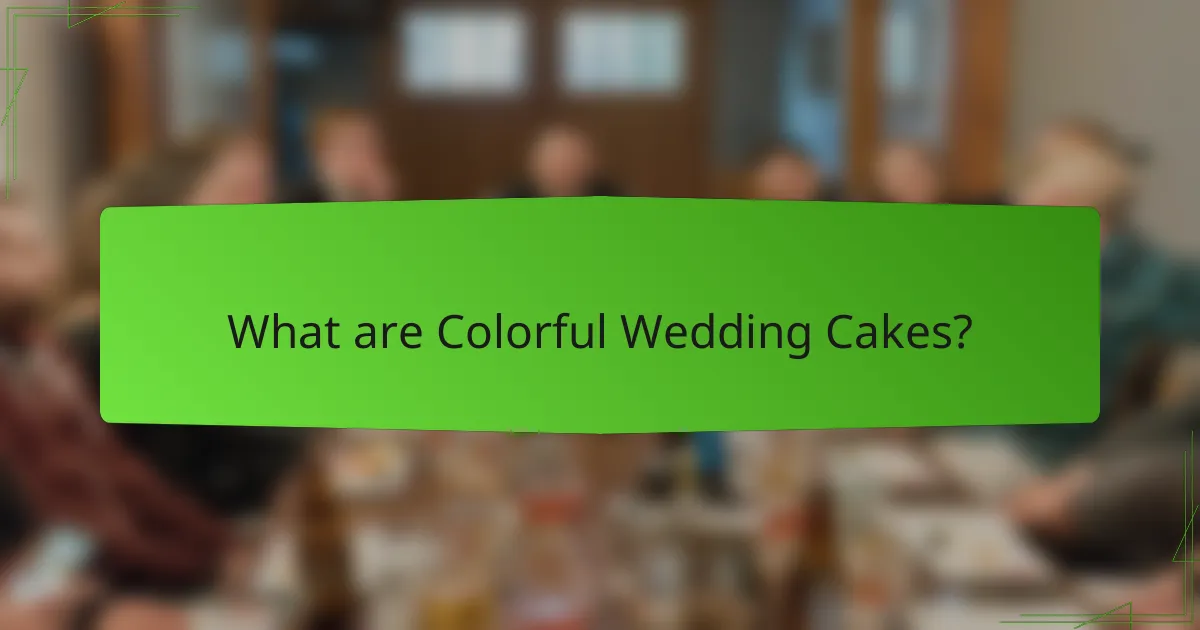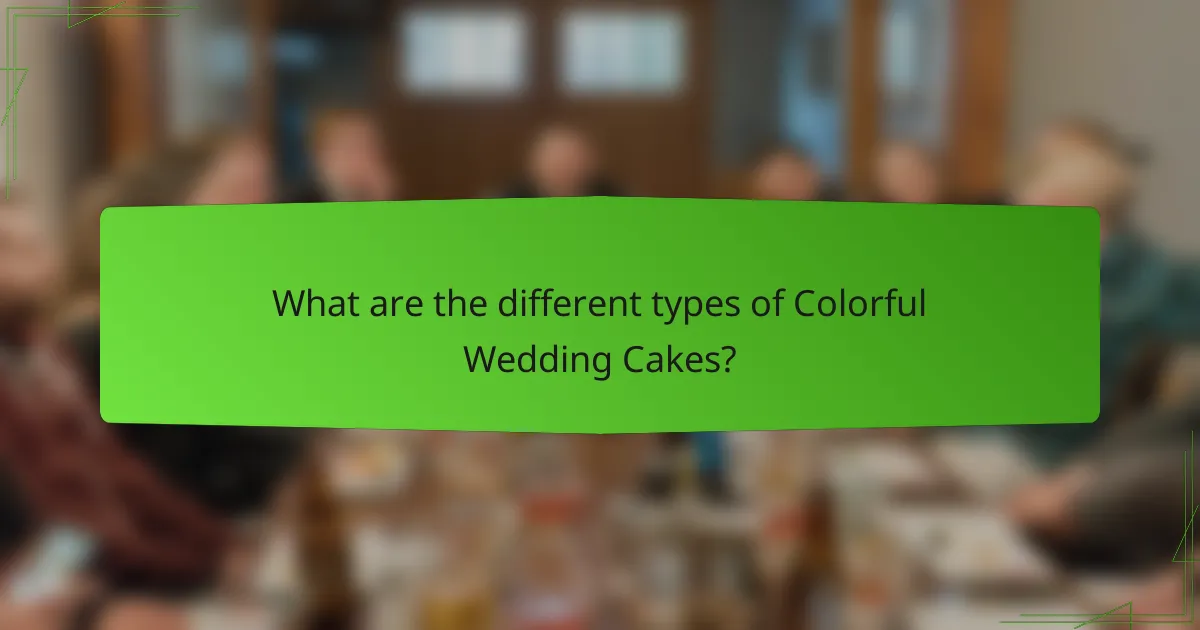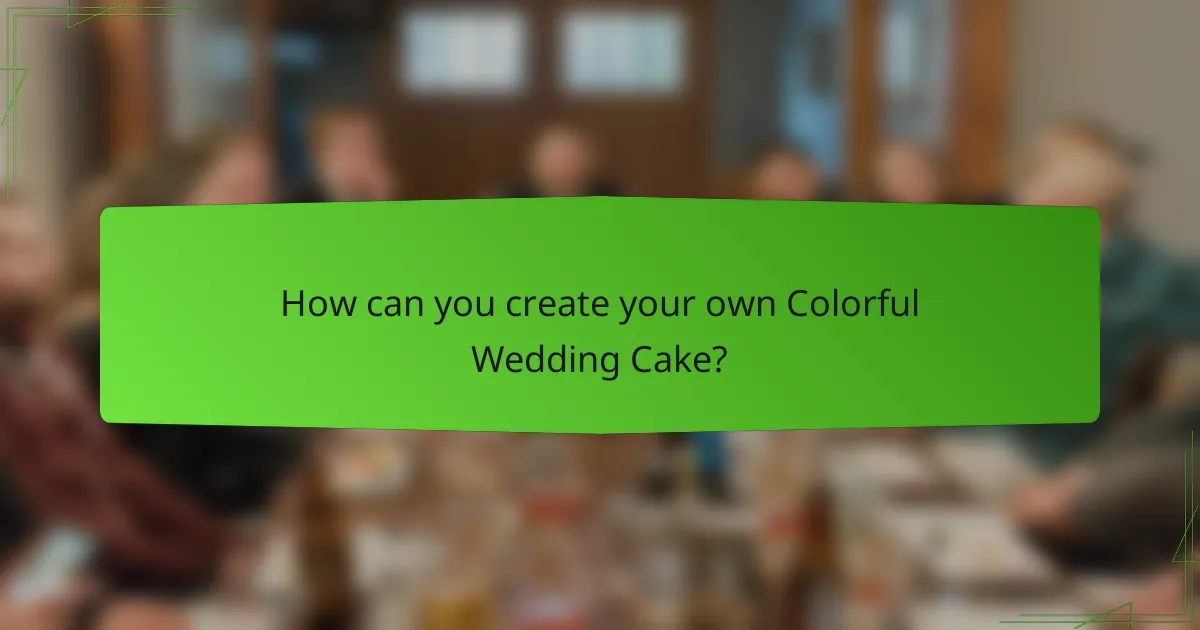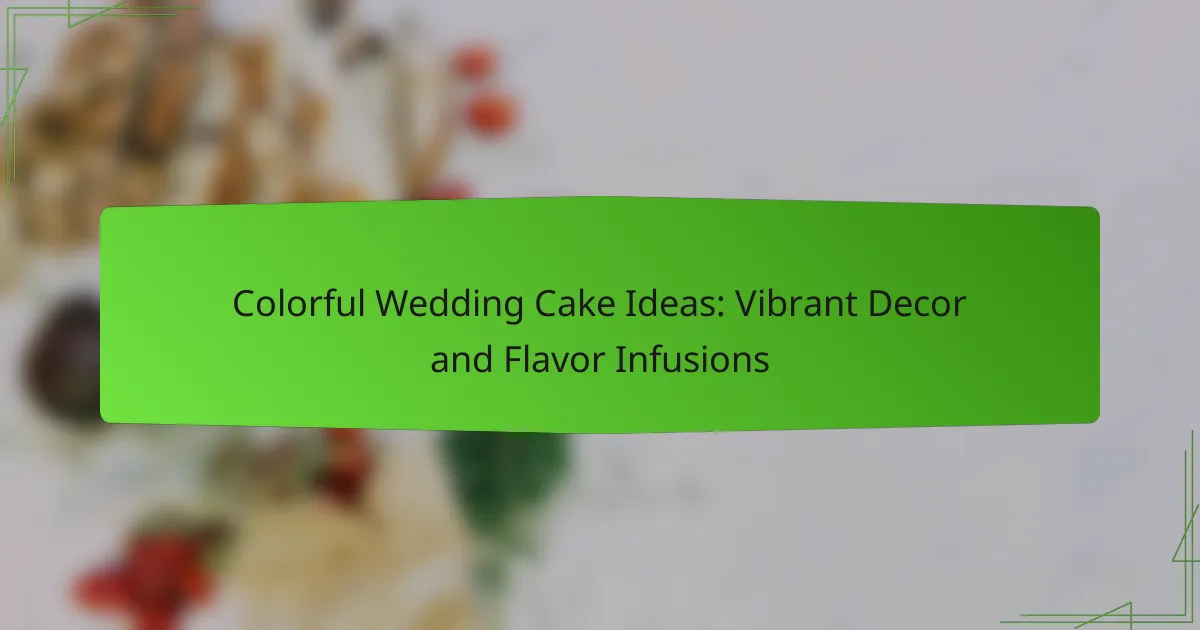
What are Colorful Wedding Cakes?
Colorful wedding cakes are visually striking desserts designed for weddings. They feature vibrant colors that enhance their aesthetic appeal. These cakes can incorporate various flavors, fillings, and decorations. Popular choices include multi-tiered designs with intricate patterns. The use of food coloring allows for a wide range of hues. Edible flowers and fresh fruits often complement the colorful designs. Many couples choose these cakes to reflect their personalities and wedding themes. Colorful wedding cakes have gained popularity for their ability to create memorable visual experiences.
How do Colorful Wedding Cakes differ from traditional cakes?
Colorful wedding cakes differ from traditional cakes primarily in their aesthetic and flavor profiles. Colorful wedding cakes often feature vibrant hues and intricate designs. These cakes use food coloring and artistic techniques to create visually stunning presentations. In contrast, traditional cakes typically have more subdued colors and simpler decorations.
Flavor infusions are also more common in colorful wedding cakes. They often incorporate unique flavors like lavender, matcha, or tropical fruits. Traditional cakes usually stick to classic flavors like vanilla, chocolate, or red velvet. The use of unconventional ingredients in colorful cakes allows for a broader range of taste experiences.
Additionally, colorful wedding cakes are often customized to match wedding themes or color schemes. Traditional cakes may not prioritize such personalization. This trend reflects modern wedding aesthetics that favor bold, creative expressions. Overall, the differences lie in visual appeal, flavor variety, and customization options.
What design elements contribute to the vibrancy of Colorful Wedding Cakes?
Vibrant design elements of colorful wedding cakes include bold colors, intricate patterns, and unique textures. Bold colors are achieved through vibrant icing and fondant choices. Intricate patterns can be created using techniques like airbrushing or stenciling. Unique textures often involve ruffles, drapes, or sugar flowers. These elements work together to create visual appeal. The combination of bright hues and detailed designs enhances the cake’s overall vibrancy. Additionally, the use of edible glitter or metallic accents can further elevate the cake’s appearance. These design choices contribute to a memorable and eye-catching centerpiece for weddings.
How do flavor profiles enhance the appeal of Colorful Wedding Cakes?
Flavor profiles significantly enhance the appeal of colorful wedding cakes by providing diverse sensory experiences. Each flavor can complement the visual vibrancy of the cake. For example, a lemon flavor can add a refreshing contrast to bright colors. Chocolate flavors can evoke richness and indulgence, balancing the cake’s aesthetic. Unique flavor combinations, such as raspberry and vanilla, can intrigue guests, encouraging them to try the cake. These profiles can also cater to various preferences, making the cake more inclusive. Statistics show that 70% of wedding cake choices are influenced by flavor, indicating its importance. Ultimately, flavor profiles not only enhance taste but also elevate the overall enjoyment of colorful wedding cakes.
Why are Colorful Wedding Cakes popular for modern weddings?
Colorful wedding cakes are popular for modern weddings due to their vibrant aesthetic appeal. They serve as a focal point for wedding receptions. The use of bright colors reflects personal style and creativity. Many couples choose colorful designs to match their wedding themes. Additionally, these cakes can incorporate unique flavors that enhance the overall experience. Studies show that visually appealing desserts increase guest satisfaction. Colorful cakes also symbolize joy and celebration, aligning with wedding sentiments. This trend has been fueled by social media showcasing stunning cake designs.
What trends are driving the demand for Colorful Wedding Cakes?
The demand for colorful wedding cakes is driven by personalization and unique aesthetics. Couples increasingly seek cakes that reflect their personalities and wedding themes. Vibrant colors enhance visual appeal and create memorable photo opportunities. Social media platforms, especially Instagram, amplify the trend for visually striking desserts. The rise of dessert tables encourages diverse cake designs, including bold colors. Flavor innovation also plays a role, with couples opting for unconventional flavors that match colorful designs. Customization options have expanded, allowing for intricate designs and color combinations. These trends collectively contribute to the growing popularity of colorful wedding cakes.
How do Colorful Wedding Cakes reflect personal style and themes?
Colorful wedding cakes reflect personal style and themes through their design and color choices. Each color can symbolize different meanings, such as red for love or blue for tranquility. Couples often choose colors that match their wedding palette or represent their personalities. The cake’s decoration, such as floral accents or unique patterns, further showcases individual tastes. For example, a rustic-themed wedding may feature a cake with earthy tones and natural elements. Additionally, flavor combinations can reflect personal preferences, enhancing the overall experience. Ultimately, colorful wedding cakes serve as a visual representation of the couple’s journey and aesthetic vision.

What are the different types of Colorful Wedding Cakes?
The different types of colorful wedding cakes include ombre cakes, watercolor cakes, and floral patterned cakes. Ombre cakes feature a gradient of colors that blend into each other. Watercolor cakes mimic the look of watercolor paintings with soft, blended hues. Floral patterned cakes are decorated with colorful edible flowers for a vibrant touch. Other types include rainbow layer cakes, which have multiple colored layers, and geometric patterned cakes that use bold colors and shapes. Each type offers a unique aesthetic for wedding celebrations.
What are the most popular color schemes for Wedding Cakes?
The most popular color schemes for wedding cakes include classic white, soft pastels, and bold jewel tones. Classic white remains timeless, symbolizing purity and elegance. Soft pastels, such as blush pink and mint green, create a romantic and delicate aesthetic. Bold jewel tones, like deep red and emerald green, add a vibrant and luxurious touch. These color schemes are often chosen to complement the overall wedding theme and decor. According to wedding industry reports, these trends have consistently ranked high in popularity among couples.
How do seasonal colors influence Wedding Cake designs?
Seasonal colors significantly influence wedding cake designs by dictating the overall aesthetic and theme. For instance, pastel colors are popular in spring, evoking a sense of freshness and renewal. In summer, bright and bold hues are often chosen to reflect vibrancy and warmth. Autumn typically brings rich, warm colors like deep reds and oranges, aligning with the season’s natural palette. Winter wedding cakes often feature cool tones, such as icy blues and whites, to capture a frosty ambiance.
These color choices not only affect the cake’s appearance but also guide flavor selections. For example, citrus flavors may complement a summer cake’s bright color scheme. Seasonal colors can also inspire decorative elements, such as floral arrangements or cake toppers, enhancing the overall design. This alignment between color and flavor creates a cohesive and memorable experience for the couple and their guests.
What unique color combinations are trending in Wedding Cakes?
Trending unique color combinations in wedding cakes include blush pink and gold, navy blue and copper, and lavender with sage green. Blush pink and gold create a romantic and elegant look. Navy blue and copper add a modern and sophisticated touch. Lavender with sage green offers a soft, natural aesthetic. These combinations reflect current design trends in weddings. They enhance the visual appeal of cakes while complementing various wedding themes.
What flavor infusions can be incorporated into Colorful Wedding Cakes?
Colorful wedding cakes can incorporate a variety of flavor infusions. Popular choices include vanilla, chocolate, and lemon. Fruity infusions like raspberry, strawberry, and orange add vibrant flavor. Exotic options such as matcha, chai, and lavender can enhance uniqueness. Additionally, spices like cinnamon or nutmeg can provide warmth. Floral infusions, including rose and hibiscus, contribute elegance. Each infusion can complement the cake’s color and design. These flavors create a multi-dimensional experience for guests.
How do fruity flavors complement vibrant cake designs?
Fruity flavors enhance vibrant cake designs by adding freshness and visual appeal. The bright colors of fruits mirror the vivid hues in cake decorations. This combination creates an inviting aesthetic that attracts attention. Fruity flavors also provide a contrast to the sweetness of cake. For example, citrus fruits can balance rich, creamy frostings. Additionally, the natural juices from fruits can add moisture to the cake. This results in a more enjoyable texture. Studies show that flavor and visual presentation significantly affect consumer preferences. Therefore, incorporating fruity flavors into vibrant cake designs is a strategic choice for appealing desserts.
What are some unconventional flavor pairings for Colorful Wedding Cakes?
Unconventional flavor pairings for colorful wedding cakes include lavender and lemon, rosemary and olive oil, and chai spice with vanilla. Lavender adds a floral note that complements the tanginess of lemon. Rosemary and olive oil create a savory contrast with sweet cake layers. Chai spice infuses warmth and complexity into traditional vanilla, offering a unique twist. Other combinations are matcha and white chocolate, as well as coconut and pineapple with a hint of chili. Matcha provides an earthy flavor that pairs well with the sweetness of white chocolate. Coconut and pineapple create a tropical essence, while chili adds an unexpected kick. These pairings enhance the visual appeal and taste experience of wedding cakes.

How can you create your own Colorful Wedding Cake?
To create your own colorful wedding cake, start by baking multiple layers of cake in different colors. Use food coloring to tint the batter before baking. Next, prepare a white or cream-colored frosting to layer between the cakes. Stack the colored cake layers with frosting in between. For decoration, apply a smooth layer of frosting around the entire cake. Use additional food coloring to create vibrant designs on the frosting. Edible decorations like sprinkles or fresh fruits can enhance the visual appeal. Ensure to let the cake cool completely before decorating. This method allows for a personalized and vibrant wedding cake that reflects your style.
What steps are involved in designing a Colorful Wedding Cake?
The steps involved in designing a colorful wedding cake include planning, choosing colors, selecting flavors, designing tiers, and decorating. First, planning involves determining the cake size and guest count. Next, choosing colors should reflect the wedding theme and palette. Selecting flavors requires balancing taste preferences with color compatibility. Designing tiers involves deciding on the number of layers and their shapes. Finally, decorating includes applying fondant, icing, and edible decorations to achieve the desired colorful effect. These steps ensure a visually appealing and delicious wedding cake.
How do you select the right ingredients for vibrant colors?
To select the right ingredients for vibrant colors, choose natural food colorings derived from fruits and vegetables. Ingredients like beet juice produce a rich red hue. Spinach offers a bright green color, while turmeric provides a vibrant yellow. These natural sources are often more intense than artificial dyes. Additionally, the use of high-quality cocoa can enhance chocolate colors. Research indicates that natural colorings are healthier alternatives to synthetic ones. The FDA has approved many natural colorings for food use, ensuring safety and quality.
What techniques can be used to achieve stunning cake decorations?
Techniques to achieve stunning cake decorations include fondant application, buttercream piping, and edible painting. Fondant provides a smooth surface for intricate designs. It can be rolled out and draped over cakes for a polished look. Buttercream piping allows for decorative borders and flowers. Piping tips create various textures and shapes. Edible painting adds a personal touch with custom designs. This technique uses food-safe colors to enhance the cake’s appearance. Techniques like sugar flowers and lace work also elevate the decoration. Sugar flowers mimic real blooms, while lace work offers elegance. These methods are widely used by professional bakers for visually striking cakes.
What tips can help ensure a successful Colorful Wedding Cake?
To ensure a successful colorful wedding cake, focus on vibrant color combinations. Select food-safe gel colors for deep, rich hues. Use white or light-colored cake layers to enhance color contrast. Incorporate natural flavors that complement the colors, like citrus or berry. Ensure even baking for a uniform texture and appearance. Decorate with fresh fruits, edible flowers, or colored frosting for added visual appeal. Maintain balance in design to avoid overwhelming the cake’s overall look. Lastly, conduct taste tests to ensure flavor harmony among layers.
How do you choose the right baker for your Colorful Wedding Cake?
To choose the right baker for your colorful wedding cake, start by researching local bakers known for vibrant designs. Look for portfolios showcasing colorful cakes that match your vision. Check online reviews and testimonials to gauge customer satisfaction. Schedule tastings to evaluate flavor and texture. Discuss your design ideas and ensure the baker can accommodate specific colors and themes. Verify their experience with wedding cakes, as this often requires more skill. Confirm they use high-quality ingredients for better taste and appearance. Finally, compare pricing and ensure it fits your budget while meeting quality standards.
What are common mistakes to avoid when planning a Colorful Wedding Cake?
Common mistakes to avoid when planning a colorful wedding cake include neglecting color harmony. Using clashing colors can create an unappealing appearance. Another mistake is overlooking flavor combinations. A cake should not only look good but also taste delicious. Failing to consider the cake’s size is also common. An improperly sized cake may not feed all guests. Additionally, rushing the design process can lead to unsatisfactory results. It’s essential to allow ample time for planning and adjustments. Lastly, not communicating with the baker can result in misunderstandings. Clear communication ensures the cake meets expectations.
Colorful wedding cakes are visually striking desserts characterized by vibrant colors and intricate designs, reflecting personal style and wedding themes. This article explores the differences between colorful and traditional cakes, highlighting unique flavor profiles and popular color schemes. Key design elements and seasonal influences on cake aesthetics are discussed, along with trends driving their popularity, such as personalization and social media impact. Additionally, the article provides insights into creating, decorating, and selecting the right ingredients for these cakes, ensuring a successful and memorable centerpiece for modern weddings.
